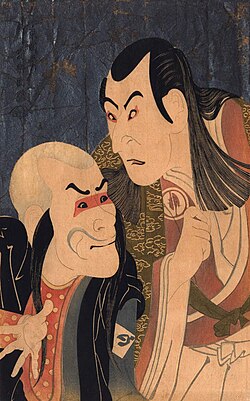Sharaku
Tōshūsai Sharaku (active 1794 - 1795) (Japanese: 東洲斎写楽) is widely considered to be one of the great masters of the woodblock printing in Japan. Little is known of him, besides his ukiyo-e prints; neither his true name nor the date of his death are known with any certainty. His active career as a woodblock artist seems to have spanned just ten months, from middle 1794 to early 1795.

Biography
One theory claims that Sharaku was not a person, but a project launched by a group of artists to help a woodblock print house that had aided them. In this theory, the name Sharaku is taken from sharakusai, "nonsense," and is an inside joke by the artists, who knew that there was no actual Sharaku. The rapidly changing style that Sharaku utilized, with four distinct stylistic changes in his short career, lends credibility to this claim. It was also common for woodblock prints of this time to involve anywhere from five to ten or more artisans working together. It seems unlikely that none of them would reveal Sharaku's true identity, or otherwise leave some information about Sharaku behind.
Another speculation associates Sharaku with the great ukiyo-e master Hokusai. This explanation stems from Hokusai's disappearance from the art world between the years of 1792 and 1796, the period that Sharaku's work began to appear. Beyond giving a reason for Hokusai's absence from the Edo art scene during this time the theory has little evidence.
Regarding his abrupt disappearance, one conjecture is that his master was unhappy with his retainer's association with the demi-monde of the kabuki theatre, instead of the more refined Noh theatre which the master supported. There is no evidence supporting or refuting this.
Retrospective observations

His career appears to have been so brief in part because the radical nature of his work aroused the hostility of the art world in Edo. One contemporary manuscript records:
- "Sharaku designed likenesses of Kabuki actors, but because he depicted them too truthfully, his prints did not conform to accepted ideas, and his career was short."
It seems likely that his prints, with their tendency to wring the last drop of truth from his subjects through close depiction of personal characteristics, left customers with a sense of unease, and made his prints difficult to sell. Further, it seems plausible that he was unwilling to compromise his art, and his critics hounded him from the art world.
Indeed, his work did not become popular among collectors in Japan until artists and collectors in the West discovered him in the late nineteenth century. He is now considered one of the greatest of all woodblock artists, and the first 'modern' artist of Japan, and the extraordinarily rare extant originals of his prints command fantastic sums at auctions.
References
- Muneshige Narazaki, Sharaku: The Enigmatic Ukiyo-e Master (Kodansha, Tokyo, 1983)
- Harold G. Henderson, Louis V. Ledoux, Sharaku's Japanese Theatre Prints: An Illustrated Guide to his Complete Work (Dover Publications, New York, 1984)
- Matthi Forrer, "Hokusai" (Bibliotheque de l'Image, 1996)
